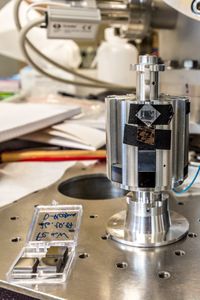BEAM-EXTERNAL
is our high productivity chamber for in-air or in-atmosphere analysis for example for battery materials, but also for other atmosphere sensitive samples. Special membrane windows connect the sample with the accelerator vacuum with minimal energy-losses. In contrast to in-vacuum analysis, this device offers advantages for handling of sensitive solids, powders, and liquids. The additional knowledge provided by IBA provides you the ideas to develop new materials and identify problems of existing solutions e.g. for increasing your battery performance over the competition. Furthermore, it allows you to improve the product quality and yield for example by on-line detection of minute amount of impurities in your educts (e.g. metals in slurries).
This device series offers you new exciting possibilities for analysis of battery materials and even working batteries (see several holder options below). It directly competes with chemical analysis methods, but offers non-destructive and direct results within a few minutes of analysis time providing you higher throughput and less preparation effort due to its physical nature. Our specially designed sample holders enable the preparation of powder samples in air tight containers with air-tight SiN windows for beam analysis, the integration into glove-boxes or even the scanning of operational cell tapes in a rotating setup. The integration into existing production lines for on-line analysis is possible upon special request.
Depending on the application, protons or deuterons of 1-5 MeV are applied. These ions induce several nuclear reactions for analysing lithium and other battery related materials and impurities. Numerous reactions exist with lithium optimal either for depth profiling or total quantification. The reaction 7Li(p,pγ 1-0)7Li at 478 keV enables the analysis of the lithium content via PIGE with high accuracy and throughput up to about 100 µm thickness. For the analysis of isotopic content for tracer studies deuterons enable the reaction 6Li(d,pγ 1-0)7Li. For the depth resolved analysis of lithium concentration NRA reactions such as 7Li(p,α0)4He or 7Li(d,α)5He offer resolution in the order of 100 nm and high yields up to several 10 µm depth. The analysis of cell cross-cuts or slurry coated tapes yields lateral inhomogeneities in coating thickness and composition and provides information on the local state-of-charge. This additional information compares well to voltametric values, but offers you new possibilities in identifying reasons for aging by telling you where the lithium is stuck. Please have a look at our poster presentation.
We solved the typical problem of strong neutron radiation when analysing lithium containing materials via a combination of special detector designs and analysis schemes, effectively protecting your staff and the sensitive detectors. The combination of sub-nA ion beam currents, a high-efficiency neutron resistant HPGe detector, and a high-resolution SDD detector yield a negligible influence of the measurement on your sample. The analysis of cells during charging revealed an impact of about 1 mV of the measurement on the active charging process. Our analysis end-station is connected to an integrated software for acquiring synchronised data of all detectors and supplementary systems. These data are fed into several physical models for evaluation, yielding the analysis results without further human interaction.
This enables you to measure the lithium content and all other elements present in your materials such as oxygen, manganese, nickel, cobalt, aluminium and others. Even trace or dopant elements such as fluorine, boron or tantalum are easily detected among numerous major constituents.




